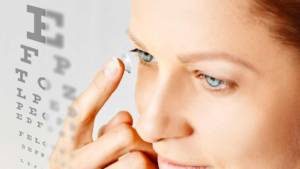Eye test for contact lenses
Contact lenses are an excellent alternative to wearing glasses. If you decide to choose contact lenses, it is very important that the lenses fit properly and comfortably and that you understand the safety and hygiene of contact lenses.
A contact lens examination will include various tests to determine the best fit for your vision and comfort.
What is the difference between an eye exam and a contact lens exam?
During a regular and complete eye exam, your optician will determine the corrections needed for your eyesight and check for certain eye diseases, such as glaucoma.
During the contact lens examination, your optometrist will determine if you have an infection that may prevent you from wearing contact lenses or that would require specialized lenses.
What should I expect during a contact lens test?

Contact lens fitting
One size does not fit all when it comes to choosing the perfect contact lenses for your eyes. Your ophthalmologist will need to take certain steps to fit them properly. Ill-fitting lenses can cause discomfort, blurred vision or even damage your eyes.
Here are some of the tests your eye doctor will perform during a contact lens eye exam to make sure you can see clearly, comfortably and safely with lenses.
Measurements of the cornea
To ensure that the curvature of the lens matches the curvature of your eye, your optician will measure the curvature of the cornea or the front surface of the eye.
Curvature is measured with an instrument called a keratometer, which helps your optician determine the proper curvature and size of your contact lenses.
If you have astigmatism, the curvature of your cornea is not perfectly round, so a “toric” lens, designed specifically for an astigmatic eye, would be suitable to give you the best possible vision. In some cases, your ophthalmologist may decide to measure your cornea in more detail using a mapping of the corneal surface called “corneal topography”.
Measure the size of your iris and pupil
Your ophthalmologist can also measure the size of your pupil or iris with an instrument called a “biomicroscope” or “slit lamp. The iris is the colored part of your eye, while the pupil is the small dark spot in the center.
This is especially important if you plan to use specialized lenses such as gas permeable contact lenses or even colored lenses.
Evaluation of the tear film
One of the most common problems that affect contact lens wear is dry eyes. If lenses are not properly moisturized and humidified, they become uncomfortable and your eyes feel dry, irritated and itchy.
A tear film evaluation is performed by the optician by placing a drop of liquid dye on your eye and then examining your tears with a slit lamp or by placing a special paper strip under the lid to absorb the tears.
This test helps the optometrist determine if you are producing enough tear film to comfortably support contact lenses. If your tear film is weak, your ophthalmologist may recommend certain types of contact lenses that are more successful at maintaining moisture to avoid discomfort.
Prescriptions for lenses
Once all the tests are completed, your ophthalmologist will decide which types of contact lenses will suit your eyes and your lifestyle. You can even try on a pair of lenses for a few minutes to confirm fit and comfort before the prescription is finalized. If the lenses seem to fit well, your ophthalmologist will order them for you.
Your optician will give you instructions on care and hygiene, including how to put in and take out your lenses, how long to wear them and how to store them.
You may also be asked to return for a follow-up appointment to make sure your new lenses are working well for you.
If you have any further questions on the subject, please do not hesitate to contact us.
The experienced optometrists at Lindegger Optique offer you a complete eye test for contact lenses.






